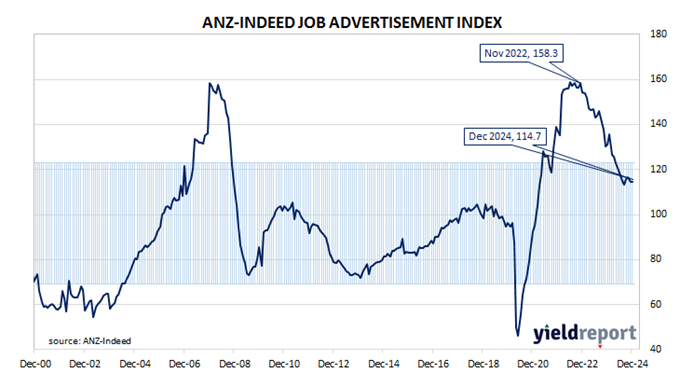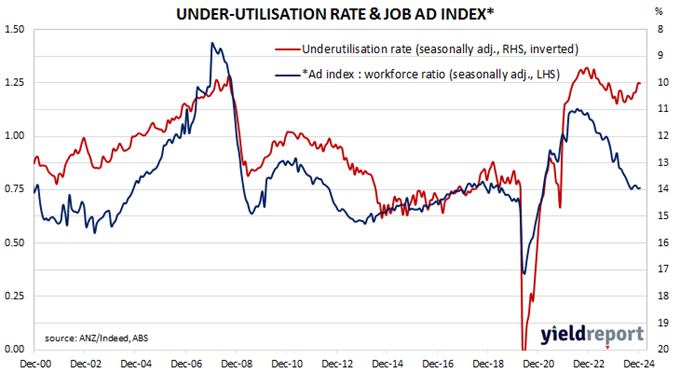Summary: Job ads rise 0.3% in December; 12.4% lower than December 2023; ANZ: first quarterly rise since Q3 2022; ACGB yields rise; rate-cut expectations soften; Indeed: growth in WA, SA, Qld offsets declines in NSW, Vic; ad index-to-workforce ratio unchanged.
From mid-2017 onwards, year-on-year growth rates in the total number of Australian job advertisements consistently exceeded 10%. That was until mid-2018 when the annual growth rate fell back markedly. 2019 was notable for its reduced employment advertising and this trend continued into the first quarter of 2020. Advertising then plunged in April and May of 2020 as pandemic restrictions took effect but recovered quite quickly, reaching historically-high levels in 2022.
According to the latest reading of the ANZ-Indeed Job Ads Index, total job advertisements in December increased by 0.3% on a seasonally adjusted basis. Their index rose from 114.4 in November after revisions to 114.7, with the gain following a 1.7% decline in November and a 0.6% rise in October. On a 12-month basis, total job advertisements were 12.4% lower than in December 2023, down from November’s revised figure of -12.2%.
“ANZ-Indeed Australian Job Ads steadied in late 2024, with the series rising 0.5% in Q4, the first quarterly rise since Q3 2022,” said ANZ economist Madeline Dunk. “This follows a cumulative decline of 13.8% over the first three quarters of the year.”
Short-term Australian Commonwealth Government bond yields jumped on the day while longer-term yields rose more moderately, somewhat in line with movements of US Treasury yields on Friday night. By the close of business, the 3-year ACGB yield had gained 13bps to 4.06%, the 10-year yield had added 9bps to 4.67% while the 20-year yield finished 4bps higher at 5.04%.
Expectations regarding rate cuts in the next twelve months softened, although a February cut is still currently viewed as a solid chance with at least one additional 25bp cut to follow. Cash futures contracts implied an average of 4.275% in February, 4.035% in May and 3.855% in August. December contracts implied 3.73%, 61bps less than the current cash rate.
“In December, growth in Western Australia, South Australia and Queensland offset declines in New South Wales and Victoria, leading to modest growth nationally,” said Indeed senior economist Callam Pickering. “We continue to have a bit of a two-speed job market with the decline in Job Ads for New South Wales and Victoria far exceeding those in other states and territories.”
The inverse relationship between job advertisements and the unemployment rate or the underemployment rate has been quite strong (see below chart), although ANZ themselves called the relationship between the series into question in early 2019.
A higher job advertisement index as a proportion of the labour force is suggestive of lower unemployment rates in the near future while a lower ratio suggests higher unemployment rates will follow. December’s ad index-to-workforce ratio remained unchanged at 0.76.
In 2008/2009, advertisements plummeted and Australia’s unemployment rate jumped from 4% to nearly 6% over a period of 15 months. When a more dramatic fall in advertisements took place in April 2020, the unemployment rate responded much more quickly.



